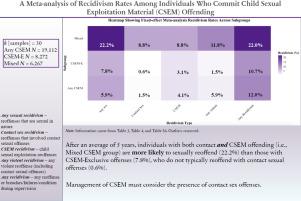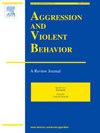儿童性剥削材料(CSEM)罪犯再犯率的荟萃分析
IF 3.4
2区 心理学
Q1 CRIMINOLOGY & PENOLOGY
引用次数: 0
摘要
管理儿童性剥削材料(CSEM)犯罪的个人面临的一个关键挑战是解决他们的性再犯风险,特别是接触性侵犯。我们对30个非重叠样本(总N = 25,978)进行了荟萃分析,其中26个样本通过官方来源(如指控)确定了CSEM指数犯罪和随后的累犯,4个样本通过自我报告确定了CSEM犯罪和随后的累犯。在平均5年的随访后,官方资料显示,有性侵犯行为的个体的固定效应再犯率为5.9% (95% CI = [5.6, 6.3], k[研究]= 21,N = 19,112), 1.5% (95% CI = [1.4, 1.7], k = 20, N = 18,543), 4.1% (95% CI = [3.8, 4.4], k = 21, N = 13,522)。根据官方资料,混合个体(性侵和接触性侵)发生接触性侵犯的几率比单一个体(性侵历史中只发生性侵)高16倍,分别为8.8%和0.6% (OR = 15.99)。还有其他几个重要的调节因素:国家官方累犯数据来源产生的比率高于地方来源(Q∆= 58.1,p < 0.0001, df = 1);官方累犯率低于自我报告累犯率(Q∆= 232.2,p < .0001, df = 1);随访时间越长,发病率越高(未标准化B = 0.01, Z = 75.8, p < .001);最近的研究显示,未标准化的比率更高(B = 0.002, Z = 68.0, p < 0.001)。本荟萃分析建立了CSEM犯罪个体的新累犯基准率,可用于为风险驱动的政策和实践提供信息。本文章由计算机程序翻译,如有差异,请以英文原文为准。

A meta-analysis of recidivism rates among individuals who commit child sexual exploitation material (CSEM) offending
A critical challenge for managing individuals with Child Sexual Exploitation Material (CSEM) offenses is addressing their risk of sexual recidivism, especially contact sexual offending. We report on a meta-analysis of 30 non-overlapping samples (total N = 25,978), with 26 samples identifying CSEM index offenses and subsequent recidivism using official sources (e.g., charges) and four samples identifying CSEM offenses and subsequent recidivism using self-report. Individuals with CSEM offenses based on official sources showed a fixed-effect recidivism rate of 5.9 % any sexual (95 % CI = [5.6, 6.3], k [studies] = 21, N = 19,112), 1.5 % contact sexual (95 % CI = [1.4, 1.7], k = 20, N = 18,543), and 4.1 % CSEM (95 % CI = [3.8, 4.4], k = 21, N = 13,522), after an average of 5-year follow-up. Based on official sources, the odds of contact sexual offenses among Mixed individuals (CSEM plus contact sexual offending) were 16 times higher than CSEM-Exclusive individuals (exclusively CSEM offenses in their sexual offending history) at 8.8 % versus 0.6 % (OR = 15.99), respectively. There were several other significant moderators: National sources of official recidivism data produced higher rates than local sources ( = 58.1, p < .0001, df = 1); official recidivism had lower rates than self-reported recidivism ( = 232.2, p < .0001, df = 1); longer follow-ups were associated with higher rates (unstandardized B = 0.01, Z = 75.8, p < .001); and more recent studies showed higher rates, unstandardized (B = 0.002, Z = 68.0, p < .001). This meta-analysis establishes new recidivism base rates for individuals with CSEM offenses, which can be used to inform risk-driven policies and practices.
求助全文
通过发布文献求助,成功后即可免费获取论文全文。
去求助
来源期刊

Aggression and Violent Behavior
Multiple-
CiteScore
7.50
自引率
4.30%
发文量
63
期刊介绍:
Aggression and Violent Behavior, A Review Journal is a multidisciplinary journal that publishes substantive and integrative reviews, as well as summary reports of innovative ongoing clinical research programs on a wide range of topics germane to the field of aggression and violent behavior. Papers encompass a large variety of issues, populations, and domains, including homicide (serial, spree, and mass murder: sexual homicide), sexual deviance and assault (rape, serial rape, child molestation, paraphilias), child and youth violence (firesetting, gang violence, juvenile sexual offending), family violence (child physical and sexual abuse, child neglect, incest, spouse and elder abuse), genetic predispositions, and the physiological basis of aggression.
 求助内容:
求助内容: 应助结果提醒方式:
应助结果提醒方式:


